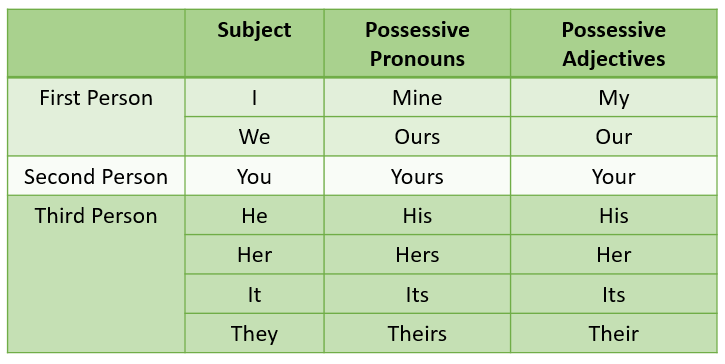Possessive Pronouns
Related Pages
Types of Pronouns
Personal Pronouns
Subject Pronouns, Object Pronouns, Reflexive Pronouns
More Lessons On English Grammar
In these lessons, we will learn
- what is a possessive pronoun
- some examples of possessive pronouns
- the differences between possessive pronouns and possessive adjectives
In English grammar, both possessive pronouns and possessive adjectives show ownership. However, they function differently in a sentence.
A possessive pronoun replaces a noun that has already been mentioned and shows ownership. It stands alone and does not need a noun to follow it. Example: This book is mine.
A possessive adjective modifies a noun and shows ownership. It always comes before a noun. Example: This is my book.
The following table gives some examples of Possessive Pronouns and Possessive Adjectives. Scroll down the page for more examples and explanations.

What Are Possessive Pronouns
A pronoun is a word that takes the place of a common noun or a proper noun.
The words mine, yours, his, hers, its, ours, and theirs are called possessive pronouns. They are used to substitute nouns to show possession or ownership.
Examples:
His boat is faster than mine.
(mine substitutes that word
boat and shows that it belongs to me)
This is my car and that is yours. (yours substitutes the word car and shows that it belongs to you)
A possessive pronoun can act as a subject of a sentence.
Examples:
His will only arrive tomorrow.
Ours is the yellow one in the room.
A possessive pronoun can act as a subject complement.
Examples:
This house is hers.
Is this kitten ours?
Common Mistakes to Avoid:
- Apostrophes: Possessive pronouns never use apostrophes (e.g., yours, not your’s; theirs, not their’s). Possessive adjectives also do not take apostrophes. Apostrophes are used with possessive nouns (e.g., John’s car).
- “Its” vs. “It’s”: “Its” is the possessive adjective. “It’s” is a contraction of “it is” or “it has”.
Examples Of Possessive Pronouns
| Subject | Possessive Pronouns | |
| Singular | I | Mine |
|---|---|---|
| You | Yours | |
| He | His | |
| She | Hers | |
| It | Its | |
| Plural | We | Ours |
| You | Yours | |
| They | Theirs |
Possessive Adjectives Or Possessive Determiners
The words my, yours, his, her, its, our and their are possessive adjectives. Do not confuse possessive pronouns with possessive adjectives. A possessive adjective is usually used to describe a noun and it comes before a noun. Possessive adjectives are also called possessive determiners.
Examples:
This bag is mine.
(mine is a possessive pronoun).
This is my bag. (my is a possessive adjective, it comes before the noun bag)
Examples Of Possessive Pronouns And Possessive Adjectives
| Singular | Plural | |||
| Possessive Pronouns |
Possessive Adjectives |
Possessive Pronouns |
Possessive Adjectives |
|
| First Person | mine | my | ours | our |
|---|---|---|---|---|
| Second Person | yours | your | yours | your |
| Third Person | his | his | theirs | their |
| hers | her | |||
| its | its | |||
Possessive Pronouns
This video shows how to use possessive pronouns like mine, yours, his, hers, ours and theirs.
Possessive Pronouns (mine, yours, his, hers, ours, theirs)
Possessive Adjectives And Possessive Pronouns
The difference between possessive adjectives and possessive pronouns.
Possessive pronouns and determiners: my, mine, your, yours, his, his, her, hers, its, our,
ours, their and theirs.
Possessive Adjectives
How to use possessive adjectives before a noun?
Try out our new and fun Fraction Concoction Game.
Add and subtract fractions to make exciting fraction concoctions following a recipe. There are four levels of difficulty: Easy, medium, hard and insane. Practice the basics of fraction addition and subtraction or challenge yourself with the insane level.

We welcome your feedback, comments and questions about this site or page. Please submit your feedback or enquiries via our Feedback page.